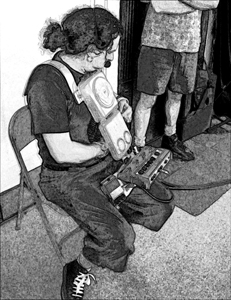![[Metroactive Music]](/music/gifs/music468.gif)
[ Music Index | Silicon Valley | Metroactive Home | Archives ]

Primadorial Loop: With a portable looping machine, infinite soundscapes can be created at the touch of a button. Finders Keepers Santa Cruz's Rick Walker finds sound in the strangest places By Rob Pratt RICK WALKER sits up, presents his hands to play air drums and starts to sing a tattoo of drum beats at 165 beats per minute. Even sitting outside a Santa Cruz cafe and talking about music, chaos and the Zen of inventing new ways to play old instruments, he has a way of snatching music out of thin air. What has inspired this latest burst of rhythm is drummer Johnny Rabb, who developed a technique of single-handedly playing strings of superfast beats. Rabb holds a Guinness Book of World Records mark as the fastest drummer on Earth for paying out an amazing 1,071 drum hits in 60 seconds, and Walker says that at a recent clinic given by Rabb, he was completely blown away by Rabb's uncanny way of using the fast-drumming technique to make beats performed on a live drum set sound as if were they were the computer-generated grooves of a drum 'n' bass DJ. That is just the sort of thing that suits Walker's musical aesthetic: a live drummer who plays like a machine and who has no fear of playing with machines, because he imagines new possibilities for music. That's the Zen of playing old instruments in new ways--of using traditional instruments with new techniques or of making music with fanciful objects dreamed up by a musician who's part sculptor, part conductor. Beginner's mind is the important concept, Walker says, and it has become the central dictum of a series of avant-garde musical events he has "curated" at the San Jose Museum of Art during recent months. The series continues Sunday at 2pm with artists Mobius Operandi, Twine and Walker's own endeavor, Loop.pooL, for the Festival of Found and Invented Sound. "When hip-hop music started in the Bronx, those artists only had old records or shitty drum-machine beats--like off an old organ," Walker explains. "They didn't know anything about 'swing factors' or '58 percent swing' [a drum-machine representation of the emphasis/de-emphasis patterns in jazz rhythms], but they found all these rhythmic gradations that can come out of machines." Musical inventiveness also comes from necessity, he adds. The modest income that percussionist Walker earns from performing and teaching has meant that his homemade instruments have to use inexpensive materials. Blue bottles, PVC tubing and other items commonly found at hardware stores populate his arsenal. "I'm a timbralist more than a rhythmatist," he says. "Rhythm is important, but I want to expand the scope of timbre in my sounds." Inventiveness with household materials and a deep interest in timbre are traits shared among the performers for Sunday's show. Like Walker, Tom Nunn, who performs as Twine, creates and plays handmade musical instruments. Nunn's, though, are fanciful inventions constructed of sheet metal rods bowed or tapped to make tones or nails plucked like the tines of a mbira. "It's kind of gamelanesque," Walker says. For his part of the performance, Walker plans to explore found sound, inviting the audience to provide a blue-bottle accompaniment to his looped-sound noisescapes or relying only on a limited palette of vocal sounds and electronic samplers to create layers of timbre. Right now, Walker continues, the prevalence of personal computers has touched off another period of musical inventiveness. People who have little or no musical training can use even inexpensive computers to sample sounds or to cut-and-mix beats. "Björk has this idea that from the early 1900s to the 1960s, you could find a piano in almost every home in America," Walker says. "That was because 19th-century advances in mass production made pianos inexpensive--or at least not as expensive as they were--and there was a proliferation of them. People who weren't professional musicians could learn to play them. She says that the laptop is the folk instrument of this millennium, and that the same thing is happening with computers as happened with the piano. "When I take on a new instrument," Walker continues, "I try to think how a master musician from Papua, New Guinea, would take on an analog synthesizer. They certainly wouldn't use it like a musician trained in Western music, but they would probably come up with some really cool ideas and some new sounds." For the events at the San Jose Museum of Art, Walker has tried to stage similar moments of beginner's-mind musical creativity. For the First All-Women's Looping Festival presented last month, he delivered a stack of electronic instruments to one of the performers and directed her to figure out something to do with it. "I was doing a looping show"--a performance of music created by layering looped sounds played on electronic samplers--"and [artist] Jesse Rose came up to me afterward and started asking all these really creative things about the looper," he says. "She didn't know anything about how to use it, so I said, 'Here--take my looper for a month and see what you can do." Sunday's show features two groups, Mobius Operandi and Twine, who create and play musical sculptures or fanciful instruments dreamed up by their creators, as well as Walker's Loop.pooL, which improvises electronic grooves with voice and everyday found objects.
The Festival of Found and Invented Sound, part of the San Jose Museum of Art's Cross-Currents Performance Series, takes place Sunday (Dec. 8) at 2pm at the museum, 110 South Market St., San Jose. Tickets are $5 at the door, free for museum members. (408.271.6840)
Send a letter to the editor about this story to letters@metronews.com. [ Silicon Valley | Metroactive Home | Archives ]
|
From the December 5-11, 2002 issue of Metro, Silicon Valley's Weekly Newspaper.
Copyright © Metro Publishing Inc. Metroactive is affiliated with the Boulevards Network.
For more information about the San Jose/Silicon Valley area, visit sanjose.com.